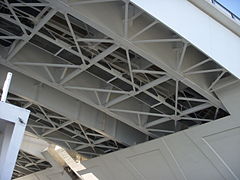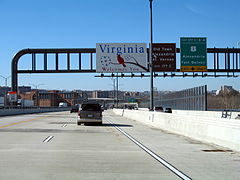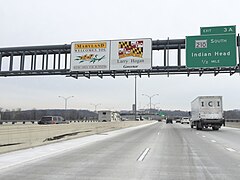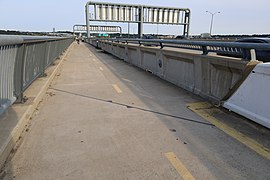Woodrow Wilson Bridge
The Woodrow Wilson Memorial Bridge, also known as the Woodrow Wilson Bridge or the Wilson Bridge, is a bascule bridge that spans the Potomac River between Alexandria, Virginia and Oxon Hill, Maryland in Prince George's County, Maryland. The original bridge was one of only a handful of drawbridges in the Interstate Highway System. It contained the only portion of the Interstate System owned and operated by the federal government until construction was completed and it was turned over to the Virginia and Maryland departments of transportation.[1]
This article is about the bridge in the Washington metropolitan area. For the bridge in Mississippi, see Woodrow Wilson Bridge (Jackson, Mississippi).
Woodrow Wilson Bridge
Woodrow Wilson Memorial Bridge in April 2007
Wilson Bridge
Double-leaf bascule bridge
6,736 feet (2,053 m)
70 feet (21 m)
December 28, 1961 (original span)
June 10, 2006 (new outer loop span)
May 30, 2008 (new inner loop span)
1961 span closed July 15, 2006. Demolished August 29, 2006.
Approx 250,000 vehicles/day
The Wilson Bridge carries Interstate 95 (I-95) and I-495 Capital Beltway. The drawbridge on the original span opened about 260 times a year, frequently disrupting traffic on a bridge that carried about 250,000 cars each day.[2] The new, higher span requires fewer openings.
The bridge's west abutment is in Virginia, a small portion is in Washington, D.C., and the remaining majority of it is within Maryland (because that section of the Potomac River is within Maryland's borders). About 300 feet (91 m) of the western midspan portion of the bridge crosses the tip of the southernmost corner of the District of Columbia. It is the only bridge in the US that crosses the borders of three state-level jurisdictions (DC, Maryland, and Virginia). The section in Washington DC is also the shortest segment of Interstate Highway between state lines.[3]
The bridge is named for the 28th president of the U.S., Woodrow Wilson (1856–1924), a native of Staunton, Virginia. While he was president, Wilson reportedly spent an average of two hours a day riding in his automobile to relax or to "loosen his mind from the problems before him". President Wilson was an advocate of automobile and highway improvements in the U.S. In 1916, he said, "My interest in good roads is [...] to bind communities together and open their intercourse, so that it will flow with absolute freedom and facility".










